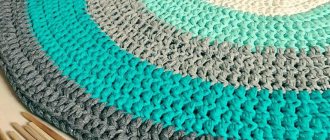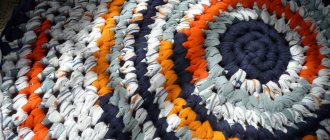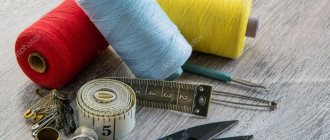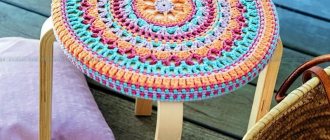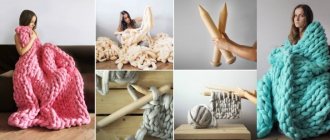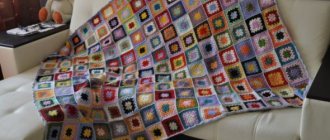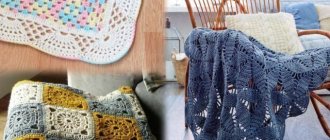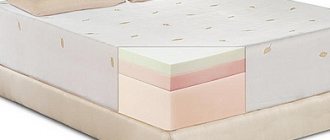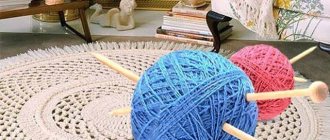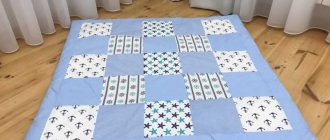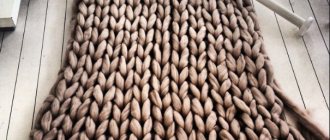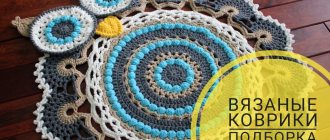Friends, do you like knitted rugs? I really like it... You look at different photographs with these products and you immediately want to knit such a miracle for yourself... despite the fact that a knitted rug, in my opinion, is a completely useless thing, although it is fabulously beautiful...
In general, one fine day I decided to knit myself a rug, and this was already 1.5 years ago...
Well, I'm a turtle, what can you do about it?
And the question immediately became, what to knit from?
In fact, there is a fairly wide selection of materials for knitting carpets... for example, the yarn that recently appeared on sale is ribbon or polyester cord, but these two options are not particularly cheap. I am a practitioner by nature, so I prefer to train on something simple so as not to throw money away.
You can knit a carpet simply from thick threads, but, again, you need to buy them and not miss...
I conducted an experiment - first I tied a thread with air loops into a regular chain, and then tried to knit a small rug from this chain... The result was not impressive either in appearance or in the quality characteristics of the product, although in the photo it looks like nothing...
I let it go (by the way, I wrote about this in the article about loose ends). But I still have a desire to try to knit something similar from a double chain...
From simple and cheap materials, fabric is perfect for knitting rugs...
Old items are cut into strips to create a ribbon from which you can knit. This is what our grandmothers did and this is perhaps the best option for this product. Material from worn-out items is worth nothing.
There is only one drawback - it will take quite a lot of time to knit even the simplest product, because... You still need to make “yarn”.
But, anyway, this is in my plans... I’ll go on vacation and start preparing ribbon yarn of my own production at the dacha (fortunately there are a lot of old things there).
In the meantime, my choice fell on plastic bags, which are not particularly expensive, come in different colors, and I just wanted to try... so my knitted rug will be made from plastic bags
So,
Which material to choose
As mentioned above, the choice is great. You can take old clothes: synthetics, T-shirts, stockings or tights, laces or ropes. By the way, cords made of polyester or polypropylene are already knitted, and they will make very good and high-quality carpets.
If you take a plastic clothesline, preferably in bright colors, you can make a rug for the bathroom, because such material is not afraid of moisture. The only thing is that it is better to make openwork patterns - this way there will be no difficulties in the knitting process.
But rugs that will lie on chairs or stools are most often made from threads or strips of old clothes. These materials are not harmful to people's skin and will be pleasant to the touch due to their low hardness.
It’s good if you have multi-colored leftover yarn - this is a wonderful, convenient material.
If you want to make a carpet for yoga or performing sports exercises at home, it is better to take soft threads and knit a product similar to a mattress cover. Then you should fill the result of the work with foam rubber or something similar.
Before you start working, you should decide exactly what shape the product will be and find a suitable diagram (the Internet is full of them). The thickness of the hook you need to purchase also depends on the thickness of the material. The number ten is most often used.
As already mentioned, there are a surprisingly wide variety of options for making a rug. All are interesting in their own way and differ in shape and materials from which they are made. Here we will look at just a few methods.
If you wish, you can easily find millions of schemes on the Internet, choose the one that you like the most and that best fits into the atmosphere of the room.
Oval shaped
Oval-shaped rugs fit perfectly into the interior and make the atmosphere more aristocratic. Despite the fact that they will look great anywhere, it is best to lay such a product in the living room. And to connect it, you need to:
- Use chain loops to cast on a chain of the required length.
- Until you can knit a semicircle, alternating double crochets and single crochets.
- Continue tying the chain on the opposite side.
- Do this until you are happy with the size of the rug.
Circle shaped
This look would look great under a dressing table, bedside table, or on the floor near the door. If you use a chunky knit, the look will radiate warmth. It's not at all difficult to do this:
- Three air loops are collected and connected.
- They knit six single crochets.
- Mentally divide the product into six parts and knit six of the same stitches in each row.
If you constantly change the configuration of the product, the pattern will become unique and inimitable. You just need to knit circles in the correct sequence and tie them in the center. A round carpet will turn out to be very interesting and will add its own accent to the overall atmosphere.
Square shaped
This type will fit perfectly into the interior of a hallway or bathroom. And if the raw material is polyethylene, then even more so. In addition, caring for such a rug is extremely simple, and it won’t take much time to make:
- First of all, columns are placed on the first row. This continues until the desired length is reached.
- The thing turns over.
- Single crochets are knitted into the outer wall of the loop of the second row.
- Things turn around again.
- Along the third row, a wall of the same columns is knitted, but now there are loops in both walls.
- Repeat the above steps until you get a satisfactory result.
Rectangle shaped
Everything is simple here - the steps are the same as in knitting a square rug, but now it is important to think about the proportions. They are slightly different, but it is not difficult to understand.
Children's variations
Children prefer their own rooms with appropriate furnishings - everything should be bright and fabulous. Therefore, the task of parents is to take into account every little detail. If you previously did not take care of purchasing furniture or textiles for the children's room with appropriate prints, then today you can easily correct the situation:
- First, buy curtains with a child's pattern for your child's room.
- Secondly, replace the existing dark blanket on the bed with a bright children's option.
- Third, tie the rug! But not a simple one, but a special one - in the form of an animal.
Do you think knitting rugs in the shape of animals is a difficult task? Not at all - here only circles, ovals, squares, hexagons, rectangles and other individually connected figures are correctly assembled into a single composition
.
For example, you can see how to knit a simple rug in the shape of a bear:
- tie the bear's face - a simple circle of a suitable size in a gray shade;
- bear ears - 2 semicircles of white and gray;
- the bear's nose is a white circle, and the triangle is cut out of black suede (later it will be sewn on);
- bear cheeks – 2 circles of pink shade;
- eyelashes - 2 suede parts, which are also later sewn on in the designated places.
The rest of the children's rugs are knitted using the same principle - use your imagination and don't look for complications in the patterns! Everything ingenious is simple!
From rags and old clothes
Work on this option begins with preparing the material. After all, in order to knit, you need to create some kind of thread. Therefore, the first step is to find raw materials. Old bed linen, bedspreads, curtains or other large pieces of fabric are perfect.
These items are cut into strips, the width of which varies from one to one and a half centimeters. Then you need to sew all the strips into one long “thread”. And then you can wind a large ball out of it.
Worn areas are removed, and normal ones are cut with a snake so that there is a minimum number of “thread” connections. This way the carpet will be neat not only from the front side, but also from the back side.
After doing all this, you can start regular knitting, as with threads.
Making a carpet from scraps of fabric will be very easy, because you only need one knitting element - a single crochet. It can be trained on simple threads using a small hook.
Once your hand is full, it will be much easier to work with a larger hook and such a difficult “thread”.
Again, the beginning is a chain of air loops that closes in a circle and becomes the beginning of a circle-shaped carpet. But a long chain can become the basis of a “row”. This is a rectangular rug consisting of many straight rows of different colors.
Yarn preparation
Crocheting rugs from rags involves preliminary preparation of yarn from them.
It consists in:
- Choosing old things based on fabric structure that match each other.
- Cutting sorted raw materials into strips.
- Selecting ribbons by color (if necessary).
- Final preparation of yarn for knitting.
In order to correctly select the necessary material for making floor mats from rags, the first step is to sort it out and sort it by type of material. That is, put knitted items in one pile, denim in another, cotton in a third, synthetic in a fourth, and so on.
- After sorting the rags by fabric quality, you should prepare them for cutting. To do this, you need to trim all the seams, that is, along the bottom of the product and the sleeves.
- Next, lay the item on a hard surface and cut it into strips from one side seam to the parallel one, but not reaching it by 2-3 cm. This is necessary in order to create one continuous strip in the future.
- When performing this operation, you should know that it is recommended to cut dense fabric into narrow strips, and thin fabric into wider ones.
- After such a cut, in place of a continuous section of material, oblique cuts are made from one strip to the next, that is, the result should be a spiral-shaped continuous strip.
- If it breaks, it is advisable to sew the ends together by placing them on top of each other. Tying knots is not recommended. This will create inconvenience during further work and spoil the appearance of the finished product.
- After cutting the tape from very frayed fabrics, before winding it into a ball, it is advisable to treat its sections with fire. This technique will secure the cut threads and extend the life of the rug.
- The resulting yarn is wound into balls.
With bumps
This funny rug looks larger than a regular one and retains heat better. It will fit perfectly into the nursery environment, giving it comfort and originality. To make such a product:
- A column is made and several double crochets are knitted from it. It should turn out that they have the same vertex.
- There should be as many double crochets as there are segments of the carpet.
- Each column is knitted with a zigzag from the beginning of the next row.
How to make a rug with your own hands using a hoop: master class
If you have a hula hoop or hula hoop, you can easily make a round mat. The hoop will act as a base. It is very convenient to work with it because of its stability.
Bright T-shirts will be the main material, as faded and gray ones will look boring. Be sure to wash your T-shirts before work.
Step-by-step making of a rug using a hoop:
- Cut the t-shirts into strips parallel to the bottom edge. You should have closed rings.
- Place one strip on the hoop, then pull the second strip perpendicularly.
- Continue stretching the T-shirt strips onto the hoop until the hoop ends up looking like a bicycle wheel. There should be an odd number of stripes on the base.
- Start weaving the rug from the center, as in the previous method. Snake the thread above and below the warp lines. Make sure the weave is tight and even.
- In the middle of the weave, divide the warp threads into two parts so that the weave doubles and is dense.
- At the end of weaving, tie all the free edges of the threads into strong knots.
- Cut the threads from the hoop and also tie them into knots.
Making a mat on a hoop
How to weave a carpet on a hoop: master class
From plastic bags
This is where it gets more complicated - knitting from a garbage bag is not at all easy. It is clear that the yarn is developed first. To do this you need:
- Connect the cut strips of the bags (the cut should be longitudinal, not transverse)
- The strips from polyethylene bags should be three centimeters wide, and those from garbage bags should be one or one and a half centimeters wide.
- The fastening of the strips can be done by tying them together in a knot, or by passing the first through the ring of the second, and then through its own ring.
By looking at a variety of photos posted on the Internet or in special printed publications, you can be inspired to create a masterpiece with your own hands.
It could be a small rug in a strict classic style or an airy cloud of flowers and ruffles, or maybe something extraordinary - it all depends on your imagination. One thing is clear - no matter what happens in the end, the most important thing is that it was done with soul and love.
Savage costume for girls
For a Papuan costume for a girl, you need to make a bright skirt (the tulle version looks good) and the top of the outfit with your own hands. For the top use:
- Top or upper part of a swimsuit.
- Sew artificial or homemade tropical-style flowers onto the upper half of the clothing and on the elastic of the skirt.
- For decoration, use jewelry, but there should not be too much of it, literally 3-4 bracelets.
- You can make a headband or elastic band from bright colors on your head.
- So that the child does not feel discomfort in the Papuan costume, under the bottom of the clothes you need to wear tights or a T-shirt with flesh-colored tights.
If the image of an African woman is chosen, then the underwear should be the appropriate color. To make the outfit ready in the shortest possible time, you can make it from New Year’s rain or dissolve a bath sponge and make a skirt from the resulting material. You can sew a T-shirt using tiger or leopard print fabric.
Interesting GOST 17.2.1.04-77 nature conservation (SSOP). atmosphere. sources and meteorological factors of pollution, industrial emissions. terms and definitions (with change n 1)
Photo of a crocheted rug
How to make a massage mat with your own hands from pebbles, chestnuts, or buttons?
Foot massage has a relaxing effect, relieves fatigue, and helps improve sleep. In addition, it has a general strengthening effect on the entire body. Since a large number of biologically active points are concentrated in the feet.
You can easily make massage mats with your own hands using available materials.
One of the available materials is sea or river pebbles. While walking along the river or seashore, collect several dozen small stones of approximately the same size.
Important: Choose rounded stones without sharp corners so as not to injure your limbs in the future.
When the stones are collected, wash them with water and laundry soap. It is also advisable to soak the stones for a couple of hours in a solution of water with potassium permanganate or in a soap solution.
Prepare a base for the mat: it can be a tarpaulin or other thick fabric. You will also need glue. Immediately take a good reliable glue, for example, moment. Hot silicone glue is not suitable for this purpose.
When the stones are dry, start gluing them onto the base. You can lay them out randomly or make some kind of pattern. There are two ways to glue stones:
- First apply glue to the base and then stick the stones on it.
- Apply glue to each individual stone and attach it to the base.
The second method will take longer, but it is more reliable. The stones will be firmly glued and will not fall off after a while. When all the stones are glued to the base, the rug should sit for about 24 hours. This way the glue will dry completely and the mat will be reliable and durable.
A rug made of stones can be placed in the bathroom or used only for massage. It is useful for adults and children to walk on stones. And if you preheat the stones, there will be double benefits for the body.
Massage mat made of stones
You can also make a rug from buttons of various sizes and shapes. It is very easy to do: sew many different buttons onto a fabric base. Any size rug is possible, but it is better to make it small. It can be easily rolled up and put away; after all, such a rug is not intended for constant walking on it. It is enough to walk on a massage mat for 5 to 15 minutes a day to engage active points.
DIY massage mat made from buttons
Another way to make a massage mat is to sew caps from felt-tip pens, plastic plugs onto a thick fabric base, stick chestnuts and other improvised materials of various shapes and textures. The result is a budget-friendly, and most importantly, useful massage mat.
DIY chestnut massage mat
MY TABLECLOUTS.
-Always at hand
—Everything is on the map
—Categories
- M.S.NORBEKOV.PSYCHOLOGY. (21)
- MISCELLANEOUS. You need to know about this. (1196)
- LAMPSHADES WITH YOUR OWN HANDS. (60)
- BATHROOM ACCESSORIES. (124)
- Album “Guipure knitting and lace”. (1)
- ANGELS WITH CROCHET AND KNITTES. (8)
- ANIMATION, PICTURES, FRAMES. (464)
- APPLICATIONS. (47)
- WATERMELONS. (4)
- ARMENIAN CUISINE. (46)
- ASSORTED KNITTING. (2)
- AUDIOBOOK. (1)
- GRANDMOTHER'S SQUARE. (917)
- BARGELLO. (6)
- PERMANENT KNITTING. (18)
- LIBRARY OF ENCYCLOPEDIA AND DICTIONARIES. (1)
- BEADING. (579)
- PANCAKES. VARENIKI. DOUGH. (133)
- DISHES IN STEAMER, MICROWAVE. (eleven)
- DISHES FROM EGGPLANT AND ZUCCHINS. (232)
- MUSHROOMS DISHES. (18)
- MEAT DISHES. (64)
- FISH DISHES. (55)
- DISHES COOKED IN THE OVEN (1)
- BROOMSTICK in pictures. (6)
- BRUGGE LACE. (174)
- CANDY STAND. (65)
- BUFFES. (15)
- WALLOW. (27)
- MITTENS, SOCKS, SLIPPERS. (436)
- VARENIKI. (6)
- VIDEO—MK. (130)
- TYPES OF YARN. (47)
- STAINED GLASS. (3)
- VOLOGDA LACE. (7)
- CROCHET AND KNITTING COLLARS. (16)
- TIME. (1)
- EVERYTHING FOR Cottage Areas. (221)
- EVERYTHING FOR VALENTINE'S DAY.. (17)
- HOUSING. (416)
- EVERYTHING FOR THE NEW YEAR'S HOLIDAY. (286)
- EVERYTHING FOR YOUR WEDDING DAY. (52)
- SECOND LIFE OF THINGS. (2)
- COOKING COOKING. (148)
- APPLE.FRUIT BAKINGS. (334)
- BAKERY. SWEETS. BEVERAGES. (2136)
- EMBROIDERY. (39)
- “PANDA” EMBROIDERY. (2)
- EMBROIDERY WITH BEADS, SEILLENS, BEADS. (257)
- STITCH EMBROIDERY. (19)
- EMBROIDERY FOR CHILDREN. (138)
- CROSS STITCH PERFECT WRONG. (43)
- EMBROIDERY RIBBONS. (196)
- RICHELIEU EMBROIDERY. (15)
- EMBROIDERY WITH WOOL STRIPES. (3)
- EMBROIDERY. (1748)
- EMBROIDERY PHOTO. (2)
- KNITTED SHOES. (3)
- KNITTING "ASPENS". (39)
- BEAD KNITTING. (27)
- KNITTING IN THE COUNTRY OF MOMS. (166)
- KNITTING COLLARS. (5)
- KNITTING FOR GIRLS. (1009)
- KNITTING FOR LITTLE BABIES. (659)
- KNITTING FOR BOYS. (217)
- KNITTING FOR MEN. (195)
- KNITTING FROM POLYETHYLENE BAGS. (26)
- CROCHET. (4148)
- KNITTING ON A FORK. (50)
- KNITTING ON LOOM. (14)
- MACHINE KNITTING. (68)
- KNITTING RAGLAN. (12)
- KNITTING. (3002)
- KNITTED TOYS, SEWED. (552)
- KNITTED SWIMSUITS. (42)
- KNITTED BAGS. (442)
- NEWSPAPER WEAVING. (157)
- SINTERITIS. (3)
- GANUTEL. (1)
- WE COOK IN POTS. (2)
- COOKING IN THE MICROWAVE. (7)
- WE'RE PREPARED FOR EASTER. (225)
- GEORGIAN CUISINE. (208)
- DECORATIVE AND APPLIED ARTS. (10)
- DECOUPAGE. (294)
- JAM DAY. (3)
- Diet of Inna Volovicheva. (26)
- DIETS. (843)
- FOR BLOGING, DIRECTORY. (312)
- HOMEMADE CHEESE. (1)
- BREATHING GYMNASTICS.EXERCISES. (69)
- JACQUARD. (356)
- LIVING AND DEAD WATER. (1)
- MAGAZINES No. 1. (128)
- MAGAZINES No. 2. (90)
- MAGAZINES No. 3. (82)
- PREPARATIONS FOR WINTER.PICKLES. (623)
- BOOKMARKS ASpen. (1)
- CASSERLES. (1)
- LET'S CHARGE WITH POSITIVE HUMOR. (95)
- HEALTHY EATING. (44)
- HEALTH. (831)
- UMBRELLAS. (67)
- GAMES. (3)
- IDEAS FROM PAPER. (172)
- PRODUCTS FROM TIGHTS. (4)
- SALT DOUGH PRODUCTS. (2)
- INTERESTING LINKS, SITES. (138)
- IRISH LACE, MODELS, DIAGRAMS. (1482)
- YOGURT. (1)
- EDGE AND EDGE BINDING DIAGRAMS. (215)
- How to drink water and lose weight. (1)
- CANAPES. (4)
- KANZASHI. (7)
- CARVING. (29)
- KVASS. (4)
- QUILLING. (35)
- KVN. (9)
- MOVIE. MUSIC. CARTOONS. (1130)
- RUGS. (658)
- CARPET EMBROIDERY. (4)
- BUTTERFLY COLLECTION. (34)
- HOUSE FLOWERS. CARE FOR THEM. (163)
- CATS. (53)
- BEAUTIFUL PHOTOS.PAINTINGS. (153)
- BAKING CREAM. (3)
- ROUND YOKETTE. (53)
- HOOK. (51)
- COOKING. (1202)
- Culinary magazine GASTRONOM. (5)
- CHICKEN IN DOUGH. (8)
- CUISINE OF THE PEOPLES OF THE WORLD. (23)
- RIBBON LACE. (87)
- PATCH SEWING. (45)
- FROGS. (5)
- MANICURE. (27)
- Master class on embroidering paintings “The perfect wrong side” (1)
- MACHINE KNITTING. (9)
- JELLYFLOWS CROCHETED AND KNEWED. (104)
- MENU for 1000 rubles per week. (104)
- FUR KNITWEAR. (7)
- MY KNITTING. (65)
- MY FAVORITE ROSES. PHOTO. (4)
- MY WANTS. (982)
- PRAYERS. PROGLORY. (202)
- ICE CREAM. (1)
- Nautical THEME IN KNITTING. (1)
- MOTIVES (HOOK). (1205)
- SOAP MAKING. (52)
- CAPS, PONCHOS. (343)
- ETHNOSCIENCE. (771)
- FURNITURE UPHOLSTERY. (3)
- FURNISHING AND REPAIR OF THE APARTMENT. (170)
- OATMEAL, SIR. (2)
- ORCHIDS. (92)
- TRANSLATION OF PAGES. (3)
- Translator of texts for knitters. (1)
- BOOTS. (258)
- PIZZA, ROLLS. (8)
- BLANKETS.BEDDREADS. (1052)
- BOBBIN WEAVING. (8)
- PLUSH CAT PILLOWS. (3)
- SELECTION OF HEALING TABLES-DIETS. (1)
- CRAFTS FROM PLASTIC BOTTLES. (2)
- FELT CRAFTS. (3)
- SUNFLOWERS. (36)
- CUSHIONS. (326)
- HAPPY HOLIDAYS CONGRATULATIONS. (18)
- USEFUL TIPS. (307)
- LENTEN DISHES, BAKING. (57)
- Losing weight. Audio psychocourse. (1)
- LOSE WEIGHT IN YOUR LEGS IN A WEEK. (1)
- POUNTS. (105)
- HAIRSTYLES FOR LONG HAIR. (28)
- PATCHWORK. (16)
- DEVELOPMENT FOR CHILDREN. (94)
- ENTERTAINMENT. (26)
- DRAWING. (29)
- RICE AND TEA MUSHROOM. (5)
- CHAMOMILES. (26)
- PAINTING. (62)
- NEEDLEWORK. (721)
- NEEDLEWORKS ON Li.ru. (397)
- ROMANIAN LACE. (86)
- SALADS. SNACKS. DISH DESIGN. (748)
- LARD.HOW TO SALTE. (5)
- NAPKINS, TABLECLOUTS. (1666)
- THE MOST INTERESTING. (23)
- DIABETES. (18)
- CANDLES. (12)
- SOVIET FILMS. (18)
- SALT. (32)
- SPOKES + HOOK. (56)
- SPOKES. (96)
- POEMS FOR THE SOUL. (329)
- DRYING. (1)
- SCHEMES FOR A DIARY. (270)
- WE COUNT KCAL. (6)
- Food calorie table. (4)
- TV. (1)
- DOUGH. (41)
- TESTS. (117)
- KRAZY TECHNIQUE - VUL. (31)
- VYTYNANKA TECHNIQUE. (5)
- Kalmyk Yoga technique. (2)
- TENERIFE TECHNIQUE. WEAVING. (1)
- FABRIC+YARN. (81)
- CAKES WITHOUT BAKE. (26)
- CAKES. (43)
- STOT PAINTING. (2)
- ACUPRESSURE. (18)
- TUNISIAN KNITTING. (33)
- TURKISH CUISINE. (2)
- TURKISH LACE. (2)
- CROCHET PATTERNS. (443)
- SOLOMON LOOPS PATTERNS. (3)
- KNITTING PATTERNS. (670)
- CAKE DECORATION. (49)
- ABDOMINAL EXERCISES. (112)
- Exercises for back pain. V. Dikul Center (8)
- PHOTOSHOP LESSONS. (20)
- SKIN, HAIR AND BODY CARE. (140)
- FENG SHUI. (36)
- FILLET-GUIPURE EMBROIDERY. (1)
- LOINT KNITTING. (666)
- FITNESS. (3)
- PHOTOSHOP. (24)
- TATTING. (12)
- FREEFORM. (124)
- X-FACTOR.VOICE. (35)
- BREAD OVEN. (8)
- COLD PORCELAIN, MOLDING. (80)
- Do you want to live longer? Buy the right products (1)
- COLOR SPECTRUM. (23)
- CROCHETED FLOWERS FROM FABRIC. (562)
- TEA MUSHROOM. (5)
- PARTIAL KNITTING. (1)
- ATTIC TOY. (5)
- COVERS FOR SOFA AND CHAIRS. (8)
- CLEANING YOUR COMPUTER. (1)
- WONDERFUL NAPKINS. (0)
- SHAWLS, SCARFS, STOLLANTES. (1253)
- CATS, HATS, Panama hats, BERETS (HOOK, SPOKES). (945)
- SEWING. (450)
- CORDS. (15)
- CURTAINS FOR THE HOME. (130)
- FUR COATS, TEAP WARMERS. (38)
- BERRIES. (0)
- JAPANESE MODELS (HOOK). (903)
- JAPANESE MODELS (SPOKES). (267)
Video lesson:
Japanese rug
Consider crochet - these rugs come from Japan, the idea was gleaned from Japanese magazines. The material of the rug is cheap Circassian yarn, acrylic mixed with wool mixture, the thread is thick and coarse. Knitted in four threads with crochet number 6. The rug consists of nine intertwined rings. Each ring has four rows.
The work begins with a chain of 50 chain stitches. The loops are closed into a ring, and single crochets are knitted into it. They also close themselves in a ring. The second row consists of single crochets, knitted in pairs in each loop. The next row is done in the same way. Pairs of single crochet stitches alternate with chain stitches. The last row is simple, consisting of single crochets. The ring is ready. When forming the next ring, the primary chain of loops is threaded through the first ring.
Selection of tools and devices for crocheting toys
Needles
Hand sewing needles come in different thicknesses and lengths. The needles are designated by numbers from No. 1 to No. 12, and the higher the number, the thicker the needle, and the thickness of the needles of two adjacent numbers is the same, but the length is different. Odd-numbered needles are longer than even-numbered needles. Standard needles are available in lengths from 35 to 80mm and thicknesses from 0.6 to 1.8mm. The required needle is selected depending on the thickness of the fabric to be worked with. The thicker the fabric, the higher the needle number and vice versa.
Fur and fabrics
Faux fur with long and short pile on a knitted base of various colors is very suitable for sewing soft toys and animal pillows. Silk fabrics are delicate and flowing. They are good for sewing doll dresses, trims, and appliqués. Felted fabrics. These include felt. Its peculiarity is that this fabric is not loose and the cut edges do not require stitching. You can cut out individual parts from felt: paws, beaks, tails, noses.
Padding materials
For stuffing toys, cotton wool and synthetic materials are used - padding polyester, padding polyester and foam rubber. It is more difficult to work with natural wool, as lumps often form when stuffed. Artificial wool - padding polyester and padding polyester are more voluminous, lighter and do not form lumps. It's much easier to work with them.
Yarn. Melange yarn
However, the section is initially spun from colorless fiber, and the finished thread is dyed in parts at certain intervals. Melange yarn is a twist of already dyed threads. One skein can combine cotton and natural wool, mohair and acrylic. It is used to knit clothes and accessories, pillows and blankets. The products are interesting due to their texture.
Wool
This is a natural material, obtained from the sheared wool of sheep since ancient times. Such wool retains heat well, neutralizes the difference between body temperature and air temperature, and is hygroscopic. Wool yarn is ideal for knitting smooth, textured and multi-colored patterns. Very often used for knitting children's items, socks, scarves and hats.
Merino wool
This is wool taken from the withers of a Merino sheep. Merinos are a breed of fine-wool sheep. The softest wool, very hygroscopic, retains heat well. Merino threads are very elastic, which allows you to knit figure-fitting items from it. Thanks to its qualities, it can be washed well both in a washing machine in a special mode and when washed by hand, without losing its qualities.
Cashmere
This is the finest fluff (undercoat) of a high-mountain cashmere goat. Refined, chic, trendy, sophisticated and rightly the most expensive material. It is no coincidence that it is called “royal yarn”, “wool diamond” or “precious thread”. Cashmere raw material consists of threads only 13-19 microns thick (human hair is 50 microns), so touching cashmere creates a feeling of splendor.
Alpaca
This is a type of llama. Alpaca wool has exceptional properties: it is light, soft, uniform and silky, maintaining a silky unique shine throughout the life of the product. Very warm, with high thermoregulating properties; durable, not subject to rolling, falling or creasing. Does not cause allergic reactions. No other type of wool has such qualities.
Hooks
Hooks come in metal, plastic and wood. It is convenient to use wooden hooks. The hooks have a diameter of 1 to 8 mm and a length of approximately 140 mm. The hook number (1; 1.5; 2; 2.5; 3, etc.) corresponds to its diameter. For example, hook No. 2 has a diameter of 2 mm. The higher the number, the larger the diameter of the hook. It is advisable for a knitter to have a set of hooks of different diameters.
To obtain a high-quality knitted fabric, it is necessary to select the diameter of the hook according to the thickness of the threads and the selected pattern. Knitting thick threads with a thin hook gives a too dense coarse knitting and is difficult to knit. Knitting thin threads with a thick hook gives a loose, uneven knitting. If the hook diameter and thread thickness are selected incorrectly, the pattern may be lost.
Accessories
Accessories are a lot of beautiful little things, without which it is impossible for us to complete the production of a toy, make it expressive, and give it an individual character. What are these little things? Multi-colored beads, white pearls of different sizes with a hole in the middle, glass beads, rhinestones, tassels, braid and lace, buttons, pieces of leather, oilcloth and fur can be used to decorate faces, eyes, decorate clothes, appliques, panels, rugs and pillows.
Why are plastic carpets needed?
Plastic bags are one of the worst offenders of wasteful products that pollute the Earth's oceans and take up limited space. This isn't new information, but Australians still produce around four billion recyclable plastic bags each year. The equivalent of 429,000 plastic bags are dumped into landfills every day; or 7250 are ejected every minute.
Opting for eco-friendly canvas bags for grocery shopping is an effective option, but many people still have excess plastic bags lying around. Instead of throwing them away, you can reuse them by investing them in multi-purpose mats.
In particular, plastic carpet can be used as sleeping mats for people who do not have access to shelter. As sleeping mats they are more hygienic, waterproof, easy to carry and provide protection against concrete. Several charities in Australia have taken up this initiative and have enthusiastically agreed to accept donations of plastic mats that will be redistributed to the homeless. So crocheting improves your quality of life.
